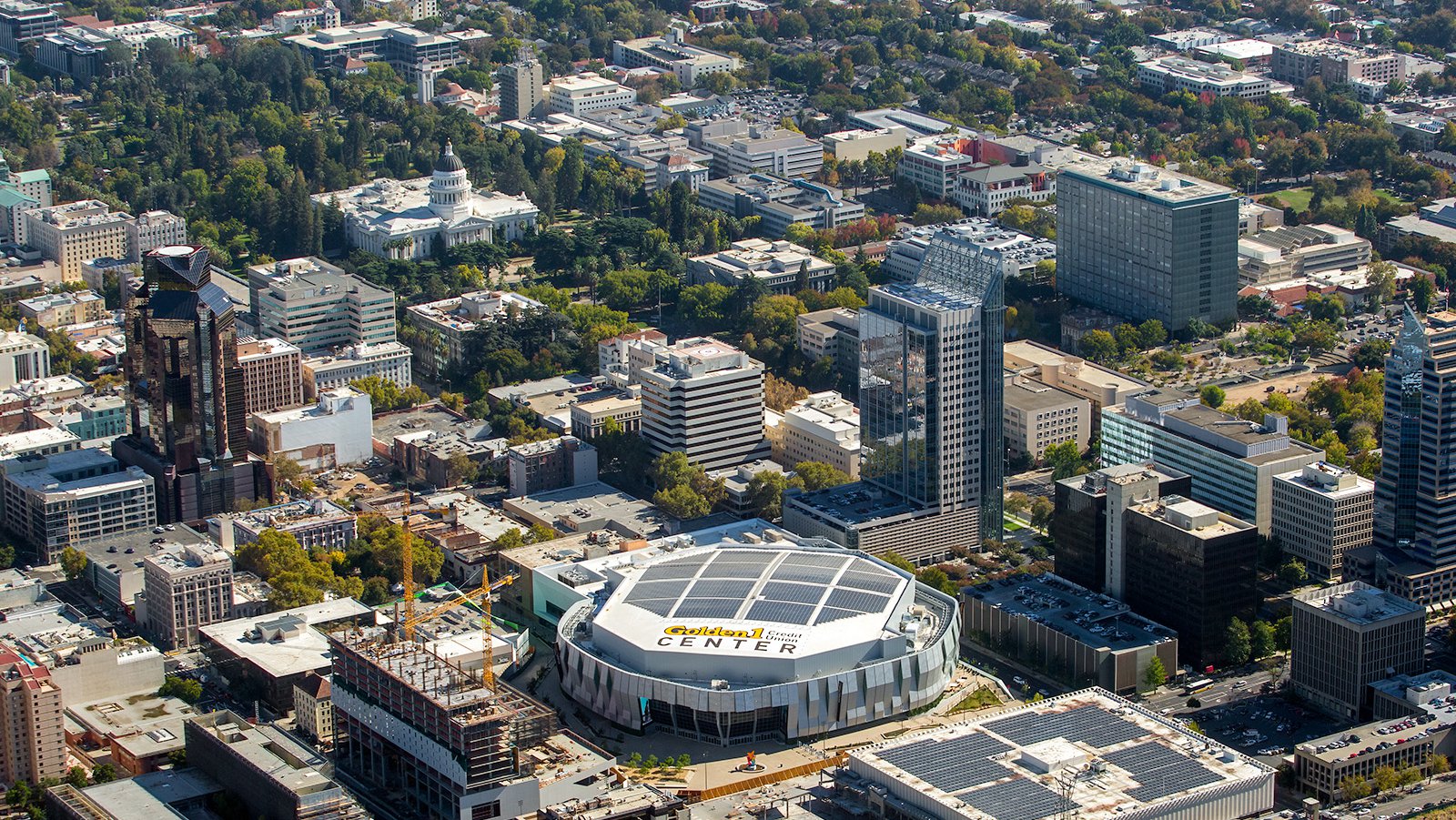State of beautiful landscapes and busy cities, California also features a set of some of the tallest and most architecturally remarkable buildings in the United States. They range from the streets of Los Angeles to the cultural hub of San Francisco, defining not just the state’s horizon but also its economic dynamism, architectural innovation, and engineering acumen. This paper discusses the tall buildings in California, covering their design, importance, and influence on the urban landscape.
The Iconic Tall Buildings of California
-
Wilshire Grand Center
Location: Los Angeles
Height: 1,100 feet (335 meters)
Completed: 2017
Architect: AC Martin
The Wilshire Grand Center is the tallest building in California. This great skyscraper, completed in the year 2017, rises to a height of 1,100 feet with its spire. It is located in Downtown Los Angeles and was designed by the architecture firm AC Martin, known for its sleek, modern form.
One of the Wilshire Grand Center’s most distinctive features is its tapering shape, which is reminiscent of a sail, thereby paying respect to Los Angeles’ seafaring past. This mixed-use building includes a luxury hotel—InterContinental Los Angeles Downtown—as well as office spaces, retail areas, and restaurants. Functionality and aesthetics are combined with developed seismic safety features to resist earthquakes common in California. The glass façade and dynamic LED lighting make the skyscraper one of the most visible in the Los Angeles skyline.
-
Salesforce Tower
Location: San Francisco
Height: 1,070 feet
Completion: 2018
Architect: Kevin Roche John Dangelo and Associates LLC
Salesforce Tower is the tallest building in San Francisco. Its construction ended in 2018. It rises 1,070 feet. Kevin Roche John Dangelo and Associates LLC designed this cylindrical skyscraper covered with glass to give off a slick, contemporary look.
Besides, the Salesforce Tower is distinctive in its sustainability features since it applies green building practices and has energy-efficient systems. Moreover, it also hosts the headquarters of the technology giant, Salesforce. This means that the building reflects the growing standing of San Francisco in the tech industry. This height and design give much importance to the developing skyline of the city, representing its standing as a technological global center.
-
Transamerica Pyramid
Location: San Francisco
Height: 853 ft. (260 m.)
Completion: 1972
Architect: William Pereira
The Transamerica Pyramid, completed in 1972, was the tallest building in California until the end of 2017 and is still an iconic image evoked upon the mention of San Francisco. This pyramid-shaped skyscraper by architect William Pereira features a unique slanting façade with a prominent spire.
This building was groundbreaking for its time because of the unique design that maximized available light and air onto the streets from the building while creating an impressive silhouette against the metropolitan sky. The building hosts offices of the Transamerica Corporation and remains one of the most easily recognized landmarks in the city, celebrating architectural novelty of the early 1970s.
-
U.S. Bank Tower
Location: Los Angeles
Height: 1,018 feet 310 meters
Completion: 1989
Architect: Henry N. Cobb of Pei Cobb Freed & Partners
Prior to the Wilshire Grand Center, the U.S. Bank Tower held the title of the tallest building in Los Angeles. Completed in 1989, the cylindrical-shaped building reaches a height of 1,018 feet, complete with a quite distinctive crown. It was designed by Henry N. Cobb of Pei Cobb Freed & Partners and is known for its high-strength concrete core with a glass curtain wall.
This skyscraper is actually a major commercial center that includes working offices for a number of high-profile tenants. Being in the central location of Downtown Los Angeles, it has become an important part of the city’s horizon, portraying the late 1980s and early 1990s in architecture.
-
Bank of America Tower
Location: Los Angeles
Height: 735 ft (224 m)
Completed in: 2009
Architect: Kevin Roche John Dangelo and Associates LLC
Completed in the year 2009, the Bank of America Tower is one of the popular skyscrapers standing at 735 feet in Downtown Los Angeles. Kevin Roche John Dangelo and Associates LLC has been responsible for its design. Its building includes a latest glass façade and obvious spire.
Basically, the tower shows the heart of sustainability by way of its energy-efficient systems and green building practices. Sleek in design, it strategically locates to rejuvenate Downtown Los Angeles as part of the evolving urban landscape of the city.
-
777 Tower
Location: Los Angeles
Height: 735 feet (224 meters)
Completed: 1991
Architect: Kevin Roche John Dangelo and Associates LLC
The other major skyscraper in Los Angeles is the 777 Tower, with a height of 735 feet. Kevin Roche John Dangelo and Associates LLC designed the building to have a modernistic structure that includes a glass curtain wall to reflect the surrounding area of Downtown Los Angeles.
This 1991 building houses office spaces and forms part of the city’s commercial scene. The height and design reflect some early 1990’s architectural trends by which high-strength materials and contemporary techniques for construction were preferred.
-
One World Trade Center
Location: Los Angeles
Height: 729 ft. (222 meters)
Completion: 2009
Architect: Michael Graves
Another major skyscraper is located in Los Angeles—the One World Trade Center, 729 feet tall. This is a unique design by architect Michael Graves, which adds variety to the city’s horizon.
The tower provides office space as well as creates the dynamic urban landscape of Los Angeles. The modern, peak extending design reflects late 2000s mode of architecture, which also contributes much to the architectural face of the city.
Impact of Tall Buildings in California
Economic Impact
The tallest buildings in California drive economic growth. Skyscrapers make a city attractive to businesses, investors, and even tourists, hence boosting the economy of the state. Such buildings provide office spaces, retail outlets, and luxury accommodations, thereby providing job opportunities and cementing California’s position as an international hub of business activities.
Urban Revitalization
Tall buildings have contributed much to the revitalization of urban areas within the state. Skyscrapers have pushed a once underdeveloped or ignored area into a thriving center of commerce and culture. New designs and central locations have allowed cities such as Los Angeles and San Francisco to be more favorable and livable.
Architectural Trends
California’s tallest buildings at the forefront of modernity: sustainable, advanced engineering techniques, and mixed-use functionality. These are likely to be taken up for adoption by future developments pushing the limits in design and construction.
The Future of Tall Buildings in California
Innovations and Trends
Increasingly dense population in California’s cities speaks to the future: more sophisticated technologies, sustainable techniques, and innovations in skyscrapers’ design. This is when mixed-use developments combining residential, commercial, and recreational spaces will define the future for the state’s skyline. Significant factors in constructing taller buildings will be innovations in engineering, specifically advanced seismic safety systems and high-strength materials.
Architectural Evolution
Future California skyscrapers would be a place in showcasing the state’s modernity and sustainability. Designs will continue to be alive, blending green spaces, renewable energy sources, and smart building technologies.
Conclusion
The tallest buildings over California, like Wilshire Grand Center, Salesforce Tower, Transamerica Pyramid, U.S. Bank Tower, Bank of America Tower, 777 Tower, and One World Trade Center, have been major feats in architecture and engineering. These skyscrapers outline the state and come to represent development, ambition, and power. As California continues to stride deep into the future, a new wave of innovations and trends will further shape its skyline, probably reflecting the vision it has for a lively, sustainable urban future. The tall buildings in California are not simply marvelous architectural pieces; they are part of its identity and progress.







